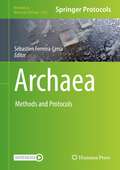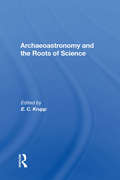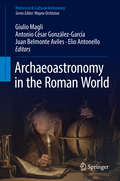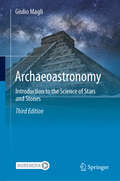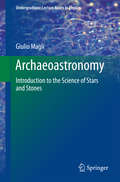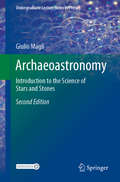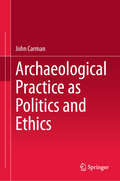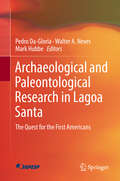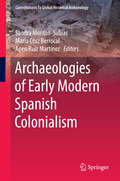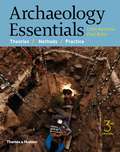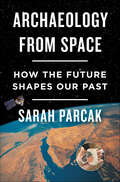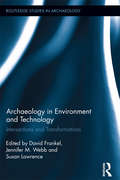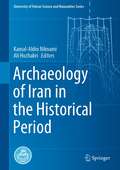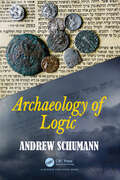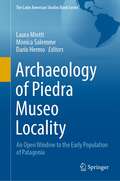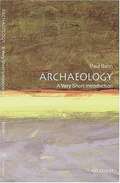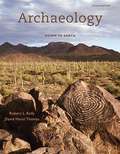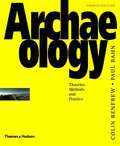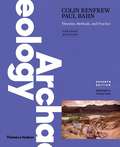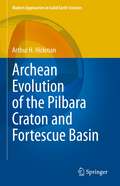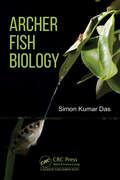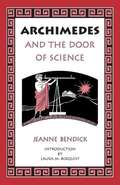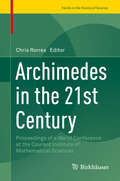- Table View
- List View
Archaea: Methods and Protocols (Methods in Molecular Biology #2522)
by Sébastien Ferreira-CercaThis volume provides an overview of well-established methods optimized for diverse archaeal model organisms and is a source of protocols facilitating access to the molecular and cellular biology characterization of these fascinating organisms. Chapters are divided into five parts detailing available genetic tools, molecular and cellular biology methods, strategies to study the ecophysiology of archaea, and classroom protocol. Each main thematic part is also introduced by future-oriented and authoritative primers. Written in the format of the highly successful Methods in Molecular Biology series, each chapter includes an introduction to the topic, lists necessary materials and reagents, includes tips on troubleshooting and known pitfalls, and step-by-step, readily reproducible protocols. Authoritative and cutting-edge, Archaea: Methods and Protocols aims to be a foundation for future studies and to be a source of inspiration for new investigations in the field.
Archaeoastronomy And The Roots Of Science
by E. C. KruppArchaeoastronomy is a rapidly developing interdisciplinary inquiry into the minds of our prehistoric and ancient ancestors, one that attempts to reconstruct the ways in which early peoples made use of the sky and its significance to them. Astronomy appears to be a fundamental component of culture, making the scope of archaeoastronomy worldwide. Thi
Archaeoastronomy in the Roman World (Historical & Cultural Astronomy)
by Giulio Magli Antonio César González-García Juan Belmonte Aviles Elio AntonelloThis book explores the insights that Cultural Astronomy provides into the classical Roman world by unveiling the ways in which the Romans made use of their knowledge concerning the heavens, and by shedding new light on the interactions between astronomy and heritage in ancient Roman culture. Leading experts in the field present fascinating information on how and why the Romans referred to the sky when deciding upon the orientation of particular monuments, temples, tombs and even urban layouts. Attention is also devoted to questions of broader interest, such as the contribution that religious interpretation of the sky made in the assimilation of conquered peoples.When one considers astronomy in the Roman world it is customary to think of the work and models of Ptolemy, and perhaps the Julian calendar or even the sighting of the Star of Bethlehem. However, like many other peoples in antiquity, the Romans interacted with the heavens in deeper ways that exerted a profound influence on their culture. This book highlights the need to take this complexity into account in various areas of research and will appeal to all those who wish to learn more about the application of astronomy in the lives and architecture of the Romans.
Archaeoastronomy: Introduction to the Science of Stars and Stones
by Giulio MagliThis book provides the first comprehensive, easy-to-read, and up-to-date account of the fascinating discipline of archaeoastronomy, in which the relationship between ancient constructions and the sky is studied to gain a better understanding of the ideas of the architects of the past and their religious and symbolic worlds. The book is divided into three sections. The first section discusses in detail the fundamentals of archaeoastronomy, including the celestial coordinates, the apparent motion of the sun, moon, stars, and planets, observation of celestial bodies at the horizon, the use of astronomical software in archaeoastronomy, and current methods for making and analyzing measurements . The second part explores the past relations between astronomy and people, power, the afterworld, architecture, and landscape The final section reviews what archaeoastronomy can now tell us about the nature and purpose of such sites and structures as Stonehenge, the Pyramids of Giza, Chichen Itza, the Angkor Temples, the Campus Martius, Machu Picchu and the Valley of the Temples of Agrigento. Additionally, it provides a set of exercises that can be performed using non-commercial free software, e.g., Google Earth and Stellarium, and that will equip readers to conduct their research. This book is an ideal introduction to what has become a wide-ranging multidisciplinary science. This newly revised edition includes the most recent research on Stonehenge, ancient Japan, and other sites worldwide.
Archaeoastronomy: Introduction to the Science of Stars and Stones (Undergraduate Lecture Notes in Physics)
by Giulio MagliThis book provides the first complete, easy to read, up-to-date account of the fascinating discipline of archaeoastronomy, in which the relationship between ancient constructions and the sky is studied in order to gain a better understanding of the ideas of the architects of the past and of their religious and symbolic worlds. The book is divided into three sections, the first of which explores the past relations between astronomy and people, power, the afterworld, architecture, and landscape. The fundamentals of archaeoastronomy are then addressed in detail, with coverage of the celestial coordinates; the apparent motion of the Sun, Moon, stars, and planets; observation of celestial bodies at the horizon; the use of astronomical software in archaeoastronomy; and current methods for making and analyzing measurements. The final section reviews what archaeoastronomy can now tell us about the nature and purpose of such sites and structures as Stonehenge, the Pyramids of Giza, Chichen Itza, the Campus Martius, and the Valley of the Temples of Agrigento. In addition, a set of exercises is provided that can be performed using non-commercial free software, e. g. , Google Earth or Stellarium, and will equip readers to conduct their own research. Readers will find the book an ideal introduction to what has become a wide-ranging multidisciplinary science.
Archaeoastronomy: Introduction to the Science of Stars and Stones (Undergraduate Lecture Notes in Physics)
by Giulio MagliThis is a second edition of a textbook that provides the first comprehensive, easy-to-read, and up-to-date account of the fascinating discipline of archaeoastronomy, in which the relationship between ancient constructions and the sky is studied in order to gain a better understanding of the ideas of the architects of the past and of their religious and symbolic worlds. The book is divided into three sections, the first of which explores the past relations between astronomy and people, power, the afterworld, architecture, and landscape. The second part then discusses in detail the fundamentals of archaeoastronomy, including the celestial coordinates; the apparent motion of the sun, moon, stars, and planets; observation of celestial bodies at the horizon; the use of astronomical software in archaeoastronomy; and current methods for making and analyzing measurements. The final section reviews what archaeoastronomy can now tell us about the nature and purpose of such sites and structures as Stonehenge, the Pyramids of Giza, Chichen Itza, the Angkor Temples, the Campus Martius, and the Valley of the Temples of Agrigento. In addition, it provides a set of exercises that can be performed using non-commercial free software, e.g., Google Earth and Stellarium, and that will equip readers to conduct their own research. This new edition features a completely new chapter on archaeoastronomy in Asia and an “augmented reality” framework, which on the one hand enhances the didactic value of the book using direct links to the relevant sections of the author’s MOOC (online) lessons and, on the other, allows readers to directly experience – albeit virtually –many of the spectacular archaeological sites described in the book. This is an ideal introduction to what has become a wide-ranging multidisciplinary science.
Archaeological Practice as Politics and Ethics
by John CarmanThis book is of relevance to all archaeologists and all others concerned with how an interest in the past impacts on the present. This book explores the manner in which archaeology as a discipline and a field of endeavour contributes to the modern world. The focus throughout the book is on practices - the range of different things that archaeologists do and how they do and have done it in order to explore the field as a distinctive aspect of social practice over time. It also concerns the structures – social, political, economic, professional, philosophical – in which archaeology is performed and the consequences for the discipline and its practitioners. Throughout there is a concern especially with archaeology as a field of political and ethical decision-making, aspects well recognised by practitioners but rarely emphasised. The book both asks and answers questions about the perception of archaeology from both within and outside the field. The book draws widely on previous work by the author and others – looking at the techniques of the field, the people involved, the political and social impacts both on and by the field. In doing so it seeks to bring these different perspectives together to create a more holistic idea of what archaeology is, has been, and could be. The book is offered to those outside the field as a justification for archaeology – a field coming under increasing pressure from those who consider it (as so many humanities and social science disciplines) as an expensive luxury.
Archaeological and Paleontological Research in Lagoa Santa: The Quest for the First Americans
by Pedro Da-Gloria Walter A. Neves Mark HubbeThis groundbreaking volume presents, for the first time in English, a broad historical review of the researches carried out over 170 years in the region of Lagoa Santa, Brazil, one of the most important archaeological regions in the Americas. From the pioneering work of the Danish naturalist Peter Lund in the XIX century to the recent research on the dispersion of early humans across South America, led by Walter A. Neves and colleagues, Lagoa Santa has offered remarkable findings, the largest collections of early human skeletons in the Americas, and has contributed to the overall discussions about the settlement of the Americas. This edited volume aims to fill the lack of publications in English about Lagoa Santa and gathers representatives of all the main Brazilian institutions directly involved in the archaeological and paleontological investigations in the region, in order to provide the international scientific community a comprehensive and complete account of the researches that contributed to rewrite the history of the peopling of the Americas. The book is organized in two parts. The first consists of chapters describing each of the interventions in the region, beginning with the pioneering work of Peter Lund and culminating with the latest intervention led by Walter A. Neves and his team. The second part of the book consists of reviews of current relevant research foci in the region, such as migrations, health, mortuary rituals, paleontology, rock art and technology.
Archaeologies of Early Modern Spanish Colonialism (Contributions To Global Historical Archaeology)
by Sandra Montón-Subías María Cruz Berrocal Apen Ruiz MartínezArchaeologies of Early Modern Spanish Colonialism illustrates how archaeology contributes to the knowledge of early modern Spanish colonialism and the "first globalization" of the 16th and 17th centuries. Through a range of specific case studies, this book offers a global comparative perspective on colonial processes and colonial situations, and the ways in which they were experienced by the different peoples. But we also focus on marginal "unsuccessful" colonial episodes. Thus, some of the papers deal with very brief colonial events, even "marginal" in some cases, considered "failures" by the Spanish crown or even undertook without their consent. These short events are usually overlooked by traditional historiography, which is why archaeological research is particularly important in these cases, since archaeological remains may be the only type of evidence that stands as proof of these colonial events. At the same time, it critically examines the construction of categories and discourses of colonialism, and questions the ideological underpinnings of the source material required to address such a vast issue. Accordingly, the book strikes a balance between theoretical, methodological and empirical issues, integrated to a lesser or greater extent in most of the chapters.
Archaeologies of Touch: Interfacing with Haptics from Electricity to Computing
by David ParisiA material history of haptics technology that raises new questions about the relationship between touch and media Since the rise of radio and television, we have lived in an era defined increasingly by the electronic circulation of images and sounds. But the flood of new computing technologies known as haptic interfaces—which use electricity, vibration, and force feedback to stimulate the sense of touch—offering an alternative way of mediating and experiencing reality. In Archaeologies of Touch, David Parisi offers the first full history of these increasingly vital technologies, showing how the efforts of scientists and engineers over the past three hundred years have gradually remade and redefined our sense of touch. Through lively analyses of electrical machines, videogames, sex toys, sensory substitution systems, robotics, and human–computer interfaces, Parisi shows how the materiality of touch technologies has been shaped by attempts to transform humans into more efficient processors of information. With haptics becoming ever more central to emerging virtual-reality platforms (immersive bodysuits loaded with touch-stimulating actuators), wearable computers (haptic messaging systems like the Apple Watch&’s Taptic Engine), and smartphones (vibrations that emulate the feel of buttons and onscreen objects), Archaeologies of Touch offers a timely and provocative engagement with the long history of touch technology that helps us confront and question the power relations underpinning the project of giving touch its own set of technical media.
Archaeology Essentials: Theories, Methods, and Practice
by Colin Renfrew Paul BahnArchaeology Essentials, already the most authoritative and accessible introduction on the market, has been updated with new discoveries, new technological innovations, revised pedagogical features, and improved illustrations. Written for today's students, Archaeology Essentials is rigorous without being over-technical and thorough without being overwhelming. The only truly global archaeology textbook available in full color, the text also provides guidance for aspiring archaeologists in the form of compelling interviews with a worldwide selection of practicing archaeologists. The third edition of Archaeology Essentials is destined to become a classic of the field.
Archaeology from Space: How the Future Shapes Our Past
by Sarah ParcakWinner of Archaeological Institute of America's Felicia A. Holton Book Award • Winner of the Phi Beta Kappa Prize for Science • An Amazon Best Science Book of 2019 • A Science Friday Best Science Book of 2019 • A Kirkus Reviews Best Nonfiction Book of 2019 • A Science News Best Book of 2019 • Nature's Top Ten Books of 2019 "A crash course in the amazing new science of space archaeology that only Sarah Parcak can give. This book will awaken the explorer in all of us." ?Chris Anderson, Head of TEDNational Geographic Explorer and TED Prize-winner Dr. Sarah Parcak gives readers a personal tour of the evolution, major discoveries, and future potential of the young field of satellite archaeology. From surprise advancements after the declassification of spy photography, to a new map of the mythical Egyptian city of Tanis, she shares her field’s biggest discoveries, revealing why space archaeology is not only exciting, but urgently essential to the preservation of the world’s ancient treasures.Parcak has worked in twelve countries and four continents, using multispectral and high-resolution satellite imagery to identify thousands of previously unknown settlements, roads, fortresses, palaces, tombs, and even potential pyramids. From there, her stories take us back in time and across borders, into the day-to-day lives of ancient humans whose traits and genes we share. And she shows us that if we heed the lessons of the past, we can shape a vibrant future. Includes Illustrations
Archaeology in Environment and Technology: Intersections and Transformations (Routledge Studies in Archaeology #8)
by Susan Lawrence David Frankel Jennifer M. WebbEnvironments, landscapes, and ecological systems are often seen as fundamental by archaeologists, but how they relate to society is understood in very different ways. The chapters in this book take environment, culture, and technology together. All have been the focus of much attention; often one or other has been seen as the starting point for analysis, but this volume argues that it is the study of the inter-relationships between these three factors that offers a way forward. The contributions to this book pick up different strands within the tangled web of intersections between environment, technology, and society, providing a series of case studies which explore facets of this common theme in different settings and circumstances and from different perspectives. As well as addressing themes of theoretical and methodological interest, these case studies draw on primary research dealing with time periods from the late Pleistocene glacial maximum to the very recent past, and involve societies of very different types. Running through all the contributions, however, is a concern with the archaeological record and the ways in which scales of observation and availability of evidence affect the development of questions and explanations. The diversity of the chapters in this volume demonstrates the inherent weakness in any attempt to prioritise environment, technology, or society. These three factors are all embedded in any human activity, as change in one will result in change in the others: social and technical changes alter relations with the environment–and indeed the environment itself—and as environmental change drives changes in society and technology. As this book shows, it is possible to consider the relationship between the three factors from different perspectives, but any attempt to consider one or even two in isolation will mean that valuable insights will be missed.
Archaeology of Iran in the Historical Period (University of Tehran Science and Humanities Series)
by Kamal-Aldin Niknami Ali HozhabriThis collection of twenty-eight essays presents an up-to-date survey of pre-Islamic Iran, from the earliest dynasty of Illam to the end of Sasanian empire, encompassing a rich diversity of peoples and cultures. Historically, Iran served as a bridge between the earlier Near Eastern cultures and the later classical world of the Mediterranean, and had a profound influence on political, military, economic, and cultural aspects of the ancient world. Written by international scholars and drawing mainly on the field of practical archaeology, which traditionally has shared little in the way of theories and methods, the book provides crucial pieces to the puzzle of the national identity of Iranian cultures from a historical perspective. Revealing the wealth and splendor of ancient Iranian society – its rich archaeological data and sophisticated artistic craftsmanship – most of which has never before been presented outside of Iran, this beautifully illustrated book presents a range of studies addressing specific aspects of Iranian archaeology to show why the artistic masterpieces of ancient Iranians rank among the finest ever produced. Together, the authors analyze how archaeology can inform us about our cultural past, and what remains to still be discovered in this important region.
Archaeology of Logic
by Andrew SchumannThe question arises whether logic was given to us by God or whether it is the result of human evolution. I believe that at least the modus ponens rule ( A and if A then B implies B) is inherent in humans, but probably many other modern systems (e.g., resource logic, non - monotonic logic etc.) are the result of humans adapating to the environment. It is therefore of interest to study and compare the way logic is used in ancient cultures as well as the way logic is going to be used in our 21st century. This welcome book studies and compares the way formation of logic in three cultures: Ancient Greek (4th century B.C.), Judaic (1st century B.C. – 1st century A.D.) and Indo-Buddhist (2nd century A.D.) The book notes that logic became especially popular during the period of late antiquity in countries covered by the international trade of the Silk Road. This study makes a valuable contribution to the history of logic and to the very understanding of the origions and nature of logical thinking. -Prof. Dov Gabbay, King's College London, UK Andrew Schumann in his book demonsrates that logic step-by-step arose in different places and cultural circles. He argues that if we apply a structural-genealogical method, as well as turn to various sources, particularly, religious, philosophical, linguistic, etc., then we can obtain a more general and more adequate picture of emengence and development of logic. This book is a new and very valuable contribution to the history of logic as a manifestation of the human mind. - Prof. Jan Wolenski, Jagiellonian University, Poland The author of the Archaeology of Logic defends the claim, calling it "logic is aftter all", which sees logical competence as a practical skill that people began to learn in antiquity, as soom as they realized that avoiding cognitive biases in their reasoning would make their daily activities more successful. The in-depth reading of the book with its diving into the comparative quotations in the long dead or hardly known to most of us languages like Sumerian-Akkadian, Aramatic, Hebrew and etc, will be rewarded by the response that the logical competence is diverse and it can be trained, despite the inevitabilitiy of the reasoning fallacies; and that critical discussions and agaonal character of the social lide are the necessary tools for that. - Prof. Elena Lisanyuk
Archaeology of Piedra Museo Locality: An Open Window to the Early Population of Patagonia (The Latin American Studies Book Series)
by Laura Miotti Monica Salemme Darío HermoThis book highlights the knowledge about landscapes and characteristics of the earliest hunter-gatherer lifeway in Southern Patagonia. It presents an analysis of the archaeological investigations carried out during three decades by an interdisciplinary team that involved archaeologists, anthropologists, paleontologists, geologists and specialists in pollen and diatoms. The database yielded was recovered from systematic survey and excavations from the Pleistocene and Holocene stratigraphic layers of the rockshelter known as AEP-1, Piedra Museo Locality, situated in the central plateau of Santa Cruz Province, Argentina. Piedra Museo is a unique place in the world of high academic interest with some of the earliest archaeological remains in the Americas. Researchers defined two strata and several Stratigraphic units in the site based on the sedimentological and pedological characteristics. The depositional zones contain archaeological remains that are interpreted as hunting events corresponding to two main different occasions in the human colonization of the region, and a third human occupation during the Middle Holocene. Last one occurred then of the massive rockshelter roof colapse. The faunal remains led to a new approach to the palaeoenvironmental evolution of this enclosed basin. This volume describes the management of lithic raw materials and social networks from first human occupation of the Patagonian region to territorial consolidation of hunter-gatherer societies.
Archaeology: A Very Short Introduction
by Paul BahnThis little book is merely intended to whet the appetite by presenting some rudiments of the subject of archaeology in the hope that the reader may be stimulated to delve more deeply into its rich literature, to carry out some research or fieldwork, or, in the case of students, decide to take it up as a university course. You may not find employment at the end of such a course, or even at the end of a Ph.D.; but in these days when even the 'safe' areas like banking no longer guarantee a job for life, you might as well enjoy yourself while you can, and - as the late Glyn Daniel often emphasized - archaeology is nothing if it is not about pleasure. Inevitably you may need to shift and sieve a lot of earth, memorize some boring dates, wrap your tongue round meaningless jargon, and try to grapple with the Sumo wrestlers of theory, but at the same time you will be transported into a world of art and artefacts, temples and tools, tombs and treasures, lost cities and mysterious scripts, mummies and mammoths.
Archaeology: Down to Earth (4th edition)
by Robert L. Kelly David Hurst ThomasThis new brief edition pairs two of archaeology's most recognized names--David Hurst Thomas of the American Museum of Natural History and Robert L. Kelly of the University of Wyoming. The authors' passionate, down-to-earth introduction to archaeological method and theory makes the book ideal for all students, whether or not they intend to pursue a career in archaeology. Students will gain an immediate, concrete impression of what the practice of archaeology involves. The authors include well-chosen examples to show how archaeologists have worked through actual problems in the field and in the lab. After using this text, students will be better able to ask questions, solve problems, and discern "truth" from "fiction. " They will learn about the nature of archaeological data and how archaeologists do such things as archaeological survey and excavation. They will also develop their sense of scientific logic and gain a better understanding of career opportunities available to archaeologists. This edition is enhanced with a new full-color design that improves the visual presentation and enables students to more clearly see the key points of an image. A rich array of supplemental resources includes a new companion website as well as the option to use the DOING FIELDWORK: ARCHAEOLOGICAL DEMONSTRATIONS CD-ROM, Version 2. 0, also developed by the authors.
Archaeology: The Discipline of Things
by Michael Shanks Christopher Witmore Timothy Webmoor Bjørnar OlsenArchaeology has always been marked by its particular care, obligation, and loyalty to things. While archaeologists may not share similar perspectives or practices, they find common ground in their concern for objects monumental and mundane. This book considers the myriad ways that archaeologists engage with things in order to craft stories, both big and small, concerning our relations with materials and the nature of the past. Literally the "science of old things," archaeology does not discover the past as it was but must work with what remains. Such work involves the tangible mediation of past and present, of people and their cultural fabric, for things cannot be separated from society. Things are us. This book does not set forth a sweeping new theory. It does not seek to transform the discipline of archaeology. Rather, it aims to understand precisely what archaeologists do and to urge practitioners toward a renewed focus on and care for things.
Archaeology: Theories, Methods, and Practice (4th Edition)
by Colin Renfrew Paul BahnA textbook on archaeology: its history; the variety of evidence; survey and excavation of sites and features; dating methods; social, environmental and cognitive archaeology; 5 case studies, and the archaeology of people.
Archaeology: Theories, Methods, and Practice (Seventh Edition)
by Colin Renfrew Paul BahnSince its first edition, Renfrew and Bahn's Archaeology: Theories, Methods, and Practice has been the leading academic source on what archaeologists do and how they do it. This indispensable book is a comprehensive introduction to archaeology in the field, the laboratory, and the library. Archaeology is organized around the key questions that archaeologists ask about the past and details the practical and theoretical ways in which answers to those questions are sought. The seventh edition has been thoroughly revised and updated to include the newest developments in the subject and the latest discoveries, and is newly designed with additional box features and extensive drawings, charts, and photographs, all in full color.
Archean Evolution of the Pilbara Craton and Fortescue Basin (Modern Approaches in Solid Earth Sciences #24)
by Arthur H. HickmanOne of today’s major geoscientific controversies centres on the origin of the Archean granite‒greenstone terranes. Is the geology of these scattered remnants of our planet’s early crust consistent with the theory that modern-style plate-tectonic processes operated from the early Archean, or does it indicate that tectonic and magmatic processes were different in the Archean? Earth has clearly evolved since its initial formation, so at what stage did its processes of crustal growth first resemble those of today? The logical place to seek answers to these intriguing and important questions is within the best-preserved early Archean crust. The Pilbara region of northwest Australia is internationally famous for its abundant and exceptionally well-preserved fossil evidence of early life. However, until recently the area has received much less recognition for the key evidence it provides on early Archean crustal evolution. This book presents and interprets this evidence through a new stage-by-stage account of the development of the Pilbara’s geological record between 3.53 and 2.63 Ga. The Archean Pilbara crust represents one fragment of Earth’s oldest known supercontinent Vaalbara, which also included the Kaapvaal Craton of southern Africa. Recognition of Vaalbara expands the background database for both these areas, allowing us to more fully understand each of them.
Archer Fish Biology
by Simon Kumar DasThis book unveils the secrets of archer fish, covering everything from their morphology to their unique feeding techniques, digestion physiology, and reproductive intricacies. It serves as an essential resource for students, researchers, conservation biologists, and anyone curious about the biology of archer fish, as well as fish biology in general. Readers can immerse themselves in chapters that discuss identification techniques, age, and growth, feeding physiology, and much more. The book highlights the wonders of these remarkable creatures, helping readers gain a deeper understanding of the intricate realm of fish biology.
Archimedes and the Door of Science
by Jeanne BendickJeanne Bendick, through text and pictures, admirably succeeds in bringing to life the ancient Greek mathematician who enriched mathematics and all branches of science. Against the backdrop of Archimedes' life and culture, the author discusses the man's work, his discoveries and the knowledge later based upon it. The simple, often humorous, illustrations and diagrams greatly enhance the text.
Archimedes in the 21st Century: Proceedings of a World Conference at the Courant Institute of Mathematical Sciences (Trends in the History of Science)
by Chris RorresThis book is a collection of papers presented at the "Archimedes in the 21st Century" world conference, held at the Courant Institute of Mathematical Sciences in 2013. This conference focused on the enduring and continuing influence of Archimedes in our modern world, celebrating his centuries of influence on mathematics, science, and engineering. Archimedes planted the seeds for a myriad of seminal ideas that would grow over the ages. Each chapter surveys the growth of one or more of these seeds, and the fruit that they continue to bear to this day. The conference speakers contributing to this book are actively involved in STEM fields whose origins trace back to Archimedes, many of whom have conducted and published research that extends Archimedes' work into the 21st century. The speakers are not historians, so while historical context is provided, this book is uniquely focused on the works themselves as opposed to their history. The breadth and depth of Archimedes' influence will inspire, delight, and even surprise readers from a variety of fields and interests including historians, mathematicians, scientists, and engineers. Only a modest background in math is required to read this book, making it accessible to curious readers of all ages.
